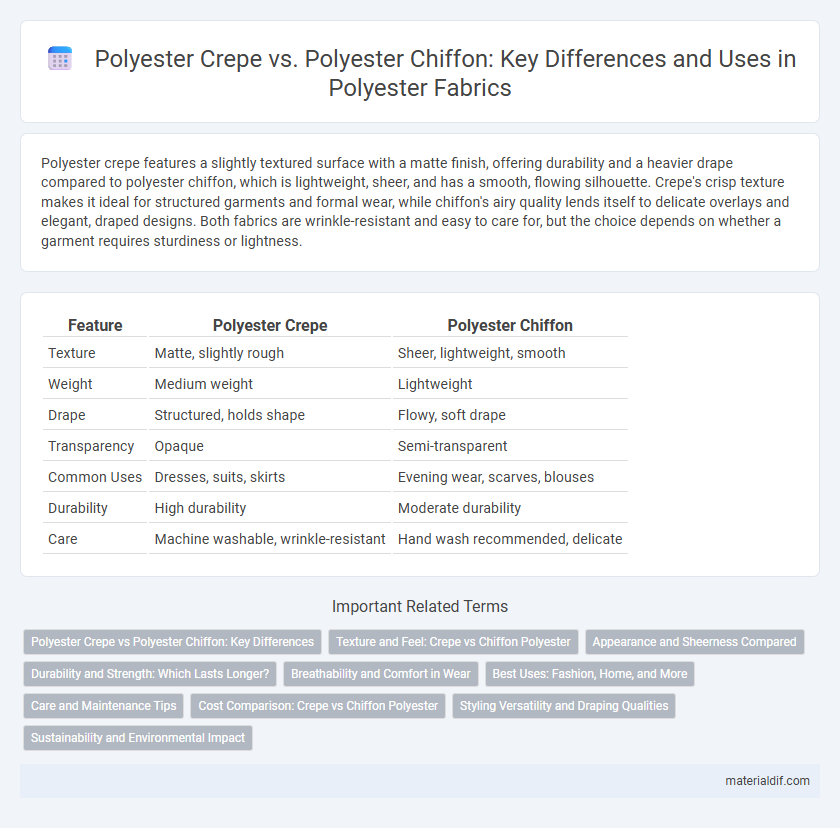Polyester crepe features a slightly textured surface with a matte finish, offering durability and a heavier drape compared to polyester chiffon, which is lightweight, sheer, and has a smooth, flowing silhouette. Crepe's crisp texture makes it ideal for structured garments and formal wear, while chiffon's airy quality lends itself to delicate overlays and elegant, draped designs. Both fabrics are wrinkle-resistant and easy to care for, but the choice depends on whether a garment requires sturdiness or lightness.
Table of Comparison
| Feature | Polyester Crepe | Polyester Chiffon |
|---|---|---|
| Texture | Matte, slightly rough | Sheer, lightweight, smooth |
| Weight | Medium weight | Lightweight |
| Drape | Structured, holds shape | Flowy, soft drape |
| Transparency | Opaque | Semi-transparent |
| Common Uses | Dresses, suits, skirts | Evening wear, scarves, blouses |
| Durability | High durability | Moderate durability |
| Care | Machine washable, wrinkle-resistant | Hand wash recommended, delicate |
Polyester Crepe vs Polyester Chiffon: Key Differences
Polyester Crepe features a textured, slightly rough surface with excellent drape and moderate stretch, making it ideal for structured garments and tailored pieces. Polyester Chiffon is lightweight, sheer, and smooth with a soft flow, perfect for delicate, airy designs and layering. Key differences lie in their texture, opacity, and weight, where Crepe offers durability and opacity, while Chiffon prioritizes lightness and translucency.
Texture and Feel: Crepe vs Chiffon Polyester
Polyester Crepe features a textured, slightly crinkled surface that offers a matte finish and a heavier, more structured feel compared to polyester chiffon. Polyester Chiffon is lightweight, sheer, and smooth with a delicate, flowing drape that provides an airy, soft touch against the skin. The distinct textures make crepe ideal for tailored garments while chiffon suits flowing dresses and overlays.
Appearance and Sheerness Compared
Polyester crepe features a matte finish with a slightly crinkled texture, providing a more opaque and structured appearance compared to polyester chiffon. Polyester chiffon is lightweight and sheer, offering a translucent look with a soft, flowing drape that enhances its delicate feel. The higher opacity of polyester crepe makes it suitable for garments requiring modest coverage, while chiffon excels in designs emphasizing lightness and elegance.
Durability and Strength: Which Lasts Longer?
Polyester crepe exhibits higher durability and strength compared to polyester chiffon due to its tightly woven texture and heavier weight, making it more resistant to wear and tear over time. Polyester chiffon, while lightweight and delicate, is more prone to snagging and stretching, thus requiring careful handling to maintain its integrity. For long-lasting wear and greater resistance to damage, polyester crepe is the preferred fabric choice.
Breathability and Comfort in Wear
Polyester crepe offers moderate breathability with a slightly textured surface that allows some air circulation, making it comfortable for extended wear in cooler conditions. Polyester chiffon, known for its sheer and lightweight structure, provides superior breathability and a breezy feel, ideal for warm weather and layered garments. Both fabrics balance durability and ease of maintenance, but chiffon excels in comfort due to its soft, airy drape.
Best Uses: Fashion, Home, and More
Polyester crepe offers a textured, matte finish ideal for structured fashion pieces like blouses and dresses, as well as home decor items such as curtains and cushion covers due to its durability. Polyester chiffon, characterized by its lightweight, sheer, and flowy nature, is perfect for elegant evening wear, scarves, and delicate home accents like drapes or table overlays. Both fabrics provide versatility, but crepe excels in formal, tailored designs and home furnishings, while chiffon shines in airy, soft garments and decorative uses.
Care and Maintenance Tips
Polyester crepe requires gentle hand washing or machine washing on a delicate cycle with cold water to maintain its textured surface, and it should be air-dried flat to prevent stretching. Polyester chiffon demands even more delicate handling, ideally hand washed with mild detergent and dried away from direct sunlight to preserve its lightweight, sheer quality. Both fabrics benefit from low heat ironing or steaming to avoid damage, with chiffon often requiring a pressing cloth to prevent melting or shiny spots.
Cost Comparison: Crepe vs Chiffon Polyester
Polyester crepe generally costs less than polyester chiffon due to its heavier weight and simpler weave, making it more affordable for bulk production. Chiffon polyester commands a higher price because of its lightweight, sheer texture and delicate construction, which require more precise manufacturing techniques. When budgeting for garments, polyester crepe offers a cost-effective option without sacrificing durability, whereas polyester chiffon is chosen for its elegance despite a higher price point.
Styling Versatility and Draping Qualities
Polyester crepe offers a heavier, textured feel with excellent draping qualities that provide structure and volume, making it ideal for tailored garments and elegant dresses. Polyester chiffon is lightweight, sheer, and fluid, enhancing styling versatility for layering, flowy designs, and delicate silhouettes in eveningwear and casual outfits. Both fabrics are durable and wrinkle-resistant, but chiffon excels in soft, ethereal drapes while crepe holds shape for more defined styles.
Sustainability and Environmental Impact
Polyester crepe and polyester chiffon both originate from synthetic fibers derived from petroleum, contributing to microplastic pollution and high energy consumption during production. Polyester chiffon tends to be lighter and more delicate, often requiring chemical treatments that increase its environmental footprint compared to the more durable polyester crepe. Sustainable alternatives focus on recycled polyester or bio-based polyesters to reduce dependency on fossil fuels and lower greenhouse gas emissions associated with both fabric types.
Polyester Crepe vs Polyester Chiffon Infographic

 materialdif.com
materialdif.com